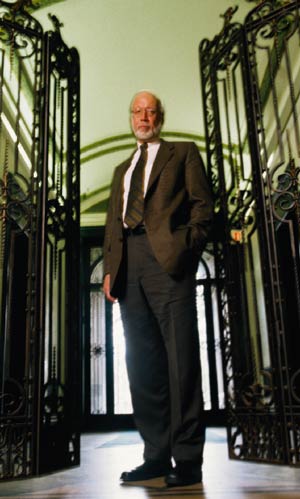 |
|
Guiding Principals Page: 2
an hour commute from York's Keele campus, Glendon College sits on the edge of a wooded ravine. Its golf course-like setting couldn't be more different
from the modernist/minimalist architecture of York's Keele/Steeles location. Once past the former estate's sandstone-and-iron gates you feel a calm descend.
Maybe it's a trick of the light, but you suddenly forget that only moments ago you were battling city traffic.
But this mid-town Toronto oasis may belie a high-stakes battle taking place beneath its elms. Some people argue that Glendon's struggle for a place within the
York community mirrors Quebec's own claim to distinct society status in an - essentially - unilingual Canada, and it's been going on for 35 years.
Glendon is, of course, one of the few universities in Canada at which students can simultaneously take courses in both English and French. Its bilingual stream was Escott
Reid's dream. Interestingly, Reid, Glendon's first principal and a former diplomat, was not bilingual himself. In his memoirs he writes, "The university did not
realize that my qualification for the job was not my accomplishments as a public servant but my lack of accomplishment: I had never learned to speak French.
My failure to become bilingual, my recognition that in future any Canadian contemplating a career as a politician or public servant should be bilingual, made me determined that Glendon should be a bilingual college.
"If I had not been successful in my demand...the college would have ceased to exist in any recognizable form some time in the '70s," he writes. Reid goes on to
say that the '70s were a time of financial stringency at Ontario universities. And that Glendon was draining York's financial resources. There was talk of moving
the college to the Keele campus. This move would have ended Glendon's objective to become a bilingual campus. "By insisting on bilingualism, I built better
than I knew....[I] saved Glendon from extinction."
Apparently Glendon's future has always been thought of as up for grabs. Nollaig McKenzie, a former Glendon philosophy professor, is quoted by Reid as saying
"there was a recurring sense of crisis. Part of the Glendon spirit came about because we had to defend the college constantly. We managed to keep the wagons
drawn in a circle when necessary."
Glendon political science alum and Toronto Star columnist Chantal Hébert [BA'76] says that in the early 1970s a bilingual college like Glendon was a novelty.
"There were fewer bilingual people around," says Hébert. "There was also Trudeau-mania. It was a phenomenon of the time. But today there's nothing unusual
about having bilingual politicians."
The image of the "two solitudes" rang truer then too, she says. It wasn't a hostility; it was a reality. However, Hébert says the reality of Glendon - as a distinct
bilingual liberal arts college - hasn't lived up to the dream. Although she says there's a pool of bilingual Anglophones that now lends it more credence.
Falling enrolments have plagued Glendon recently, causing some people to question its mandate and future. But even in the past, Glendon has suffered falling
numbers. Enrolment had dipped to about 900 students when Philippe Garigue became principal in 1980. Garigue embraced Reid's original vision for Glendon
and went one step further. "My idea was to promote Glendon as the best institution to get a bilingual education," he says. "I started to promote the idea of
attracting the Francophonie - this was the key word for the future. I wanted to change the notion of francophone to mean anyone who wanted to study in French and both languages, after all, French is a world language not a national one. I said [in Montreal] that
the future of bilingualism was not in Montreal but in Toronto." Maybe he was right. By the time he left in 1987, enrolment had soared to more than 2,000.
Kenneth McRoberts, Glendon's newest principal, maintains the college's enrolment is now on its way back up after a period of decline. Total figures for the
1999-2000 year stands at 1,677 students (including full- and part-time students). First-year enrolment (from September 1999) was 474 students, up from 453 the
previous year. And as of February 2000, there has been a 30 per cent increase (compared to the same time a year ago) in the number of first-year student
applications for September 2000.
|
Continue
|
Text Menu
[ Home | Past Issues | Subscriptions | Contact Us | Site Map | Search Profiles ]

